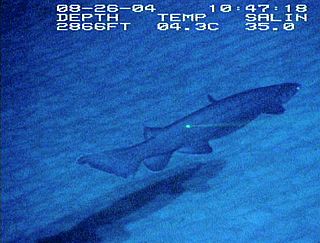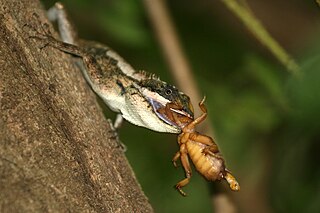Related Research Articles

The Sri Lanka white-eye is a small passerine bird in the white-eye family, which is endemic to Sri Lanka. It is a resident breeder in forests, gardens and plantations, mainly in the highlands.

Boiga ceylonensis is a species of rear-fanged, mildly venomous, nocturnal, arboreal colubrid snake endemic to Sri Lanka.

The elongated tortoise is a species of tortoise found in Southeast Asia and parts of South Asia.

The spotted houndshark, Triakis maculata, is a houndshark of the family Triakidae found in tropical waters in the eastern Pacific Ocean off the coast of South America. It usually grows to a length around 180 centimetres (71 in). The reproduction of this houndshark is ovoviviparous, with a litter of 14 pups being found in one female with a birth size of 30 to 40 centimetres. Their diet is believed to consist mainly of crustaceans.

The southern African frilled shark is a species of shark in the family Chlamydoselachidae, described in 2009. It is found in the deep waters off southern Angola to southern Namibia. This species is difficult to distinguish from the better-known frilled shark, but is smaller at maturity and differs in several proportional measurements including head length and mouth width. It seems to be a specialized predator of smaller sharks, using its flexible jaws and numerous needle-like, recurved teeth to capture and swallow them whole. Reproduction is presumably aplacental viviparous, as with the other member of its family.

The spongehead catshark is a rare species of deep-sea catshark, family Scyliorhinidae. This species was only known from two specimens taken in the Pacific Ocean: an adult from near Bird Island, Hawaii, and a juvenile from the Banda Sea off Sulawesi. They are found on or near the bottoms of insular continental slopes, at depths of 570 to 1,480 meters. In 2002, the spongehead catshark was seen alive in its natural habitat for the first time, from the submersible Pisces IV at a depth of about a kilometer, on the Northampton Seamount off the northwestern Hawaiian Islands.

Nannophrys guentheri is an extinct species of frog in the family Dicroglossidae. It was endemic to Sri Lanka. The species was first identified in 1882 by George Boulenger and named after the German-born British zoologist Albert Günther. It is not known where in Sri Lanka the specimens were found.
The whitefin swellshark is a species of catshark, belonging to the family Scyliorhinidae, endemic to southeastern Australia. It is found 126–554 m (413–1,818 ft) down, on the outer continental shelf and upper continental slope. Reaching 1.1 m (3.6 ft) in length, this shark has a very thick body and a short, broad, flattened head with a large mouth. It is characterized by a dorsal color pattern of dark saddles and blotches over a brown to gray background, and light fin margins. When threatened the whitefin swellshark can inflate itself with water or air to increase its size. Reproduction is oviparous. As of 2019 The International Union for Conservation of Nature (IUCN) has assessed this species as Critically Endangered due to the significant decline of the population.
The saddled swellshark is a rare species of catshark, and part of the family Scyliorhinidae, endemic to Eastern Australia. This bottom-dwelling species is found on the outer continental shelf and upper continental slope at a depth of 115–605 m (377–1,985 ft). It is a robustly built shark with a short, broad, flattened head and a capacious mouth. Adults are patterned with saddles on a brownish or grayish background, which varies between tropical and temperate sharks; juveniles are light-colored with many spots. This shark reaches 74 cm (29 in) in length. Like other swellsharks, it can inflate itself as a defensive measure. Reproduction is oviparous.
The narrowbar swellshark is a rare species of catshark, and part of the family Scyliorhinidae, known only from two specimens collected near Flinders Reef off northeastern Australia. This species reaches at least 44.5 cm (17.5 in) in length, and has a stocky body with a short, broad head. It can be readily identified by its zebra-like dorsal color pattern of transverse brown bars on a yellowish background. Like other swellsharks, it can inflate its body as a defensive measure.

Garra ceylonensis is a species of ray-finned fish in the cyprinid family. It is endemic to rivers and streams in Sri Lanka - and is considered as a schooling fish. It is a rheophilic species and occurs in slow to moderately flowing rivers and streams, and ascends small, rocky streams in order to breed. It primarily feeds on algae such as diatoms.
The flagtail swellshark is a little-known species of catshark, belonging to the family Scyliorhinidae, found at a depth of 480–700 m (1,570–2,300 ft) off northeastern Queensland, and possibly also nearby islands. This stout-bodied shark has a short, broad, and flattened head with a capacious mouth. Adults have a variegated brown coloration with 9–10 darker dorsal saddles and V-shaped blotch at the tip of the upper caudal fin lobe. Juveniles are yellow with narrow brown bars instead of saddles, and a distinctive marking between the spiracles shaped like two loops connected by a line. Like other swellsharks, this species can inflate its body when threatened.
Rhabdophis ceylonensis is endemic to the island of Sri Lanka. The species is commonly known as the Sri Lanka blossom krait, the Sri Lanka keelback, and මල් කරවලා or නිහලුවා (nihaluwa) in Sinhala. It is a moderately venomous snake.
Aspidura ceylonensis, also known as the Ceylon keelback, black-spined snake, or slender mould snake, is a colubrid snake endemic to Sri Lanka. It is locally known as කුරුන් කරවලා or රත් කරවලා in Sinhala.

Calotes ceylonensis, commonly known as the painted-lipped lizard or the Ceylon bloodsucker, is a species of lizard in the family Agamidae. It is one of four Calotes species endemic to Sri Lanka.
Astycus cinnamomeus, is a species of weevil found in Sri Lanka.
Myllocerus zeylanicus is a species of weevil found in Sri Lanka.
Myllocerus curvicornis, commonly known as coconut ash weevil, is a species of weevil found in India and Sri Lanka.
Reddyanus ceylonensis is a species of scorpion in the family Buthidae endemic to Sri Lanka.
References
- ↑ "Amphorygma ceylonensis Marshall, 1916". www.gbif.org. Retrieved 2021-08-18.
- ↑ "Amphorygma ceylonensis". ukrbin.com. Retrieved 2021-08-18.
- ↑ "THE FAUNA OF BRITISH INDIA, INCLUDING CEYLON AND BURMA: COLEOPTERA. RHYNCHOPHORA :-CURCULIONIDaE" (PDF). faunaofindia. Retrieved 2021-08-15.